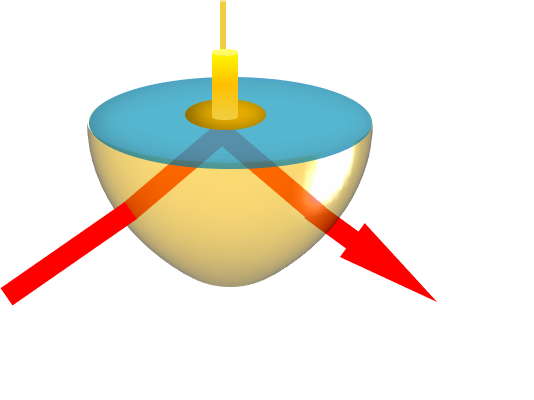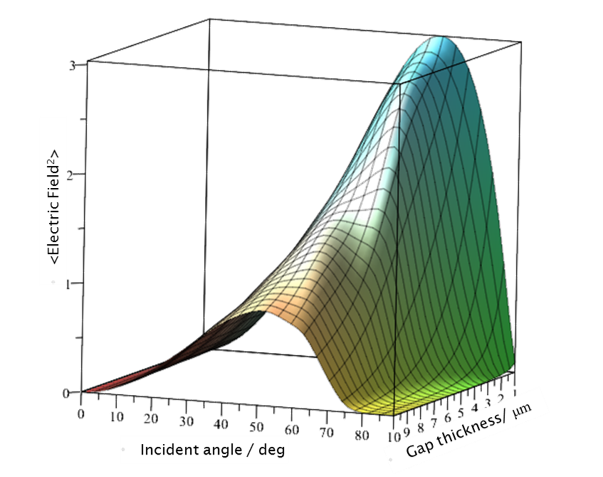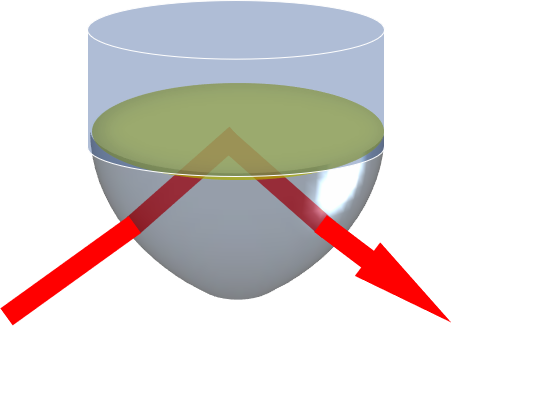Wondering what the difference is between external and internal reflection techniques for infrared spectroelectrochemistry? Read on for a short introduction and to learn why ATR-SEIRAS is our technique of choice for surface-sensitive measurements.
Studying the molecular composition of the boundary between two materials, such as an electrode|electrolyte interface, is an inherently challenging problem due to the relatively small numbers of molecules at a surface compared to those in a bulk phase. Mechanisms that preferentially increase surface molecule sensitivity are highly desirable for such studies and there are two limiting approaches for surface enhanced infrared spectroelectrochemistry.
External Reflection

In external reflection techniques, a highly polished metal electrode is pushed close to a suitably IR-transparent crystal forming a thin (ca. 10 µm) pocket of electrolyte. IR light transmitted through the crystal, reflects from the metal surface and is sent to the detector.

Upon reflection at the metal-solution interface, the electric field of p-polarized light undergoes a 180° phase shift whereas s-polarized light does not. Thus, at the interface, a theoretical enhancement factor, (E/Eo)2= 4, can be generated for p-polarized light (see Figure below). The contribution of solution based species to the measured p-polarized absorbance can be removed by subtracting the equivalent measurement made with s-polarized light. External reflection methods are often performed with either static wire grid polarizers (SNIFTIRS : subtractively normalized interfacial Fourier Transform Infrared Spectroscopy) or rapidly electromodulated crystals (PM-IRRAS : polarization modulation infrared reflection absorption spectroscopy).
Advantages
- electric field distribution at the interface can be accurately calculated
- quantitative information on surface concentrations and molecular orientation can be extracted
Disadvantages
- low surface enhancement factor (up to 4)
- infrared light has to pass through the highly absorbing electrolyte solution
Internal Reflection
ATR-SEIRAS (attenuated total reflection surface enhanced infrared absorption spectroscopy) in an internal reflection technique that overcomes the problems associated with solvent absorption. In ATR-SEIRAS a high refractive index internal reflection element (IRE) such as ZnSe, Ge or Si is modified by a thin film of nano-textured metal. As is the case in ATR, an evansecent wave is generated at angles above the crtical angle and this evansecent wave is coupled into localized plasmon polariton modes of the metallic film.

In simplistic terms, ATR-SEIRAS is analogous to its vibrational cousin SERS although it is important to note that surface enhancement in ATR-SEIRAS can be generated at almost all metals (see forthcoming note on the ATR-SEIRAS mechanism). Unlike external reflection methods, the enhancement is highly localized to the very surface of the metal and, as a good rule of thumb, the electric field enhancement drops off very rapidly beyond distances greater than 5-10 nm from the metal surface.
Advantages
- High surface enhancement factors (up to 100)
- Excellent surface sensitivity
- Not limited to plasmonic metals
Disadvantages
- Surface enhancement factors are hard to quantify
- Metal film preparation can be difficult
The Jackfish SEC J1 and J1W spectroelectrochemical cell is an out of the box solution for performing ATR-SEIRAS measurements with the PIKE VeeMAX III variable angle accessory. Check our Products page for more information.